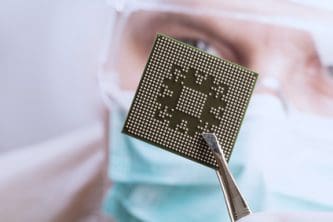COVID-19 pandemic and the China-US trade war changed the landscape of the tech industry, causing instability in the global economics, virtualization of the work environment and scarcity of high-end electronic components. The semiconductor market highly affected, and the unprecedented chip shortage that started in 2020 continued. In this article we present the most important semiconductor trends for 2022, including the evolution of the chip shortage, the next step in Moore’s law, the arise of RISC-V architecture and new growth markets in semiconductor applications.

Chip Shortage Continues Until 2023
From 2020 to now, more than 169 industries were affected by the global chip supply shortage, caused by a combination of factors, including increase in electronics demand, unstable global economics, and the COVID-19 pandemic. Moreover, because chip manufacturing requires tons of water, the production was greatly affected by the severe drought in Taiwan, which controls more than a half of the global semiconductor market. Because the production could not meet the market demand, the chips that didn’t run out of stock had their price increased way beyond the MSRP. The automotive industry alone, which absorbs 15% of the global chip production, lost more than 210 billion dollars in 2021.

Although global economics is finally starting to recover from the pandemics, it is likely that the market still needs a couple of years to ease the supply deficit, thus the shortage is expected to continue up to 2023. However, several company executives and experts forecast that the situation will already improve in 2022, and both Qualcomm CEO Cristiano Amon and AMD CEO Lisa Su believe the production will catch-up with the demands after the second half of 2022, perhaps due to the deals both companies signed with Global Foundries in the second semester of 2021. The vice-president of Samsung, Han Jin-man, also believes in an increase in supply power at the second semester of 2022. On the other hand, Nvidia CEO Jensen Huang, ARM CEO Simon Segars and Intel CEO Pat Gelsinger are less optimistic, as they don’t expect any alleviation in the shortage before 2023, or at very least until the end of 2022. Either way, the consensus is that the shortage will continue throughout 2022.
Nevertheless, the shortage is not bad news for the semiconductor business. In fact, the large increase in demand combined with the global production halt made the prices skyrocket, creating the perfect scenario for investors. The president of SEMI Taiwan, Terry Tsao, predicts that investments in wafer manufacturing will grow to US$ 8.5 billion in 2022. The global semiconductor market is expected to grow to US$ 601 billion, which corresponds to an 8.8% increase, according to the WSTS, mostly attributed to the sensors and logic chips category. Besides money opportunities, the shortage is forcing foundries to optimize production and consumers to search for alternatives in chip manufacturing. For instance, major foundries are investing heavily in production automation, machine learning and data analytics, which can be used to reduce production cost and increase overall throughput, without losing quality. Furthermore, the installation of new fabs is already starting in the US. At the customer size, big companies are migrating to in-house chip production and increasing the diversification of the supply chain. The urge for better distribution methods, the decentralization of chip production and the rise of AI driven manufacturing provide all the ingredients for innovation in the field.
Single Digit Nodes and Chiplets Gaining More Popularity
The prediction made by Gordon Moore in 1965, based purely on empirical observation, determines that the maximum transistor density inside a chip, and hence the computing power, doubles every two years. He predicted it so well that it became a law, that lived strong and well until last year. However, the director of the Microsystems Technology Office of DARPA, Robert Colwell, predicted 8 years ago that Moore’s Law wouldn’t see the light of 2022, stopping probably at the 7 or 5nm node. As we know now, TSMC announced the 3nm in 2020, overcoming the 5nm performance limitations by using the gate-all-around (GAA) technology. The giant Taiwanese company plans to start production by the end of 2022, giving at least one last breath to Moore’s prediction. Samsung also expects to produce the 3nm node in 2022. However, if the life of the law depended only on conventional monolithic chip production, it would probably not outlive its creator. This is because, besides the physical limitation of brute-force transistor shrinkage, the cost and time necessary to manufacture tech-leading nodes is becoming more and more unpractical. Thus, 2022 will probably bring the death of Moore’s law, right? Well, not according to Intel CEO Pat Gelsinger, that expects to go even faster than Moore’s law by using the chiplet technology. Chiplets divide a single die into several small dies that work together in an optimized package. 3D chiplets go one step further, and stack multiple chiplets on top of each other. Both Intel and AMD are planning to implement chiplets in the next generation of processors, with AMD having the upper hand by using 3D stacking combined with the 7nm node in collaboration with TSMC.
Open-Source Hardware Getting into Mobile Phones
Designing a new microprocessor is hard and requires many professionals with different specialties working in synergy. Therefore, when a designer wants to create an application, such as a new microcontroller or SoC, he selects the best suited processor architecture in the market, pays the license fee and plugs the IP core into his design. Proprietary instruction set architectures (ISA), such as Intel and ARM, completely dominated the market for several years. To sustain technological dominance, the companies fight to keep the design secrets safe, so the reasoning behind any design decision remains hidden. Although this approach is understandable from a business perspective, it makes it difficult for early-stage companies to put new devices into the market due to the costly IP fees, which in turns reduce competition and innovation.

In this scenario, the RISC-V architecture was developed. The RISC-V is an open-source ISA developed at the University of Berkeley, California, based on the reduced instruction set principles. It is completely open-source and free to use, which embraces small businesses and new developers without requiring fees to use. The open-source nature allows the development of a community of different contributors, kickstarting innovation and optimization. Although still shy in comparison with the proprietary giants, the RISC-V should face an exponential growth in market revenue in the next few years, according to Deloitte Global, doubling its revenue this year in comparison with 2021. But why is the market trending towards RISC-V? The main reason is China: as the trade war with the US continues, the country is facing severe sanctions in different technological fronts, and the risk of receiving restrictions in their ISA favors the migration to open-source solutions. By implementing RISC-V in their chips, China shields itself from external influence and becomes one step closer from chip self-sufficiency. Besides China, the RISC-V market also includes start-ups and early-stage companies, but big companies are already starting to catch-up. Some of the players that are already using RISC-V designs include Samsung, Microchip, Google, Nvidia and Qualcomm. Although the future of RISC-V in the industry is still uncertain, the popularization is inevitable. For perspective, the first RISC-V smartphones are expected to be launched already in 2022.
Environmental Programs are in Focus
According to Applied Materials, one foundry with 50,000 wafer starts pet month consumes a terawatt-hour of energy, which is equivalent to a city with 100,000 people, and two to four million gallons of ultra-pure water a day. After the Taiwan drought significantly delayed the production of TSMC, chip makers are running towards more aggressive sustainability programs to reduce the environmental impact of chip production. For instance, Intel plans to completely migrate to renewable power sources until 2030, which would preserve 4 billion kWh of energy. Moreover, Intel intends to obtain a net positive water use , which according to them means restoring completely the water use and supporting water conservation programs. TSMC also has a 2030 sustainability plan: to reduce unit water consumption by more than 30%, increase water regeneration by 30% and improve the water pollution indicator beyond 30%. However, TSMC failed to meet sustainability objectives in 2020, and its water consumption doubled every 2 years, following the increase in chip demand. This suggests that the company may receive more pressure from the public and the government in the near future, especially due to the deals with car makers.
New Applications Accelerate Market Growth
– Going 5G: The long promised 5G network that would make the world wireless has finally arrived, and the applications go way beyond telecommunications: customized private 5G networks will bring high-speed, high-capacity, low-latency connectivity to indoors industry and government networks. The increase in 5G penetration in new smartphones will contribute to the high demand for new chips in 2022, especially for mmWave frontends and IoT devices.
– Automotive: For the semiconductor industry car technology is the new playground. Radar chips, sensor, safety and more silicon are put into use in new cars. Both startup and large IDM are putting together ICs and solution for electrical cars as we speak.
– Artificial Intelligence: AI, machine learning and data analyses is now present in almost any high-end smart device. The recent advancements in AI hardware and acceleration will demand a great number of specialized ASICs in 2022, promising to add more heat to the chip market.
– Cloud Demand: The demand for servers is likely going to increase in 2022. The category can expect some interesting innovations, as Intel and Google recently announced their collaboration in the development of the Mount Evans, an ASIC optimized for cloud infrastructure, and Alibaba launched their new server chip, the Yitian 710.